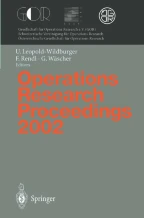Abstract
In an experiment subjects are asked to predict the next value of an univariate time series on the basis of the past observations. The average forecasts of the subjects can be well described by a surprisingly simple rule, which is called the “Bounds and Likelihood procedure”(Becker/Leopold 1996). In a new series of the experiment, conducted 2002 in Graz with 72 participants, the behaviour and score of the subjects is further analysed with the Selective Attention Test (subset of D2, Brickenkamp 1962) and Intelligence Test for Reasoning (subset of PSB, Horn 1969).
Access this chapter
Tax calculation will be finalised at checkout
Purchases are for personal use only
Preview
Unable to display preview. Download preview PDF.
Similar content being viewed by others
Reference
Becker, O., Leopold-Wildburger, U. (1996) The bounds & likelihoodprocedure — A Simulation Study concerning the efficiency of visual forecasting techniques: Central European Journal of Operations Research and Economics 4, Iss. 2/3, 1996,223–229
Brickencamp, R. (1962) Aufmerksamkeits-Belastungs-Test (Test d2). Gottingen, Hogrefe
Fisher, I. (1896) Appreciation and Interest. New York
Fisher, I. (1930) The Theory ofInterest. New York
Hayek, F. A. (1948) Individualism and Economic Order;. University of Chicago Press
Horn, W. (1969) Priifsystem fur Schul-und Bildungsberatung PSB. Gottingen, Hogrefe
Selten, R. (2001) What is Bounded Rationality, in Gigerenzer & Selten (Eds.), Bounded Rationality, MIT Press, 26–27
Author information
Authors and Affiliations
Editor information
Editors and Affiliations
Rights and permissions
Copyright information
© 2003 Springer-Verlag Berlin Heidelberg
About this paper
Cite this paper
Becker, O., Leitner, J., Leopold-Wildburger, U., Schuetze, J.H. (2003). Bounds & Likelihood Procedure Revisited. In: Leopold-Wildburger, U., Rendl, F., Wäscher, G. (eds) Operations Research Proceedings 2002. Operations Research Proceedings 2002, vol 2002. Springer, Berlin, Heidelberg. https://doi.org/10.1007/978-3-642-55537-4_74
Download citation
DOI: https://doi.org/10.1007/978-3-642-55537-4_74
Publisher Name: Springer, Berlin, Heidelberg
Print ISBN: 978-3-540-00387-8
Online ISBN: 978-3-642-55537-4
eBook Packages: Springer Book Archive
